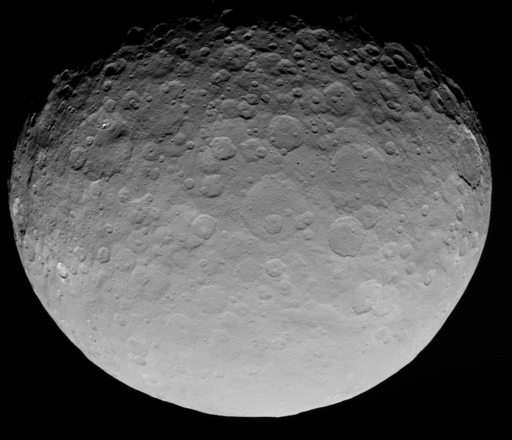1 September 2016
Sulfur, sulfur dioxide and graphitized carbon observed on asteroid for first time
Posted by Lauren Lipuma
by Alan Fischer
Hubble Space Telescope observations of the dwarf planet Ceres have discovered the first evidence of sulfur, sulfur dioxide and graphitized carbon found on an asteroid. The sulfur species are likely associated with regions of recent activity, according to the authors of a new study detailing the findings in Geophysical Research Letters, a journal of the American Geophysical Union.

Ceres is the largest object in the main asteroid belt, and, along with Pluto, is classified as a dwarf planet. Hubble Space Telescope observations of Ceres have discovered the first evidence of sulfur, sulfur dioxide and graphitized carbon found on an asteroid.
Credit: NASA/JPL-Caltech/UCLA/MPS/DLR/IDA
The discoveries were made by comparing Ceres’ ultraviolet-visible spectra to laboratory measurements. The new HST observations are complementary to observations being made by instruments on the Dawn spacecraft in orbit at Ceres, covering additional wavelengths. The presence of graphitized carbon is consistent with weathering of carbonaceous material on the asteroid’s surface, caused by processes such as charged particle bombardment, according to the study authors.
“For the first time, a carbon-rich asteroid has been observed in the spectral region where graphitized carbons show unique spectral features,” said Amanda Hendrix, a senior scientist at the Planetary Science Institute (PSI) in Tucson, Arizona. “Other dark asteroids probably have graphitized carbon on their surfaces as well.”
“This is a window to evidence of the effects caused by direct exposure to space for a primitive asteroid surface,” said Faith Vilas, a senior scientist at PSI and co-author of the study.
“Both sulfur and sulfur dioxide are volatile species at typical Ceres temperatures – they aren’t likely to stick around for long before they sublimate and are lost to space,” Hendrix said. “These species could also migrate to cold regions on Ceres, such as some shadowed craters, where they are stable. The presence of these volatile species on the surface suggests that they have recently been emplaced, perhaps by some sort of geothermal activity. Both Dawn observations and Herschel Space Telescope observations have suggested recent activity at Ceres, so it may be that sulfurous materials are involved in the activity.
“It is remarkable that Ceres has this graphitized carbon covering much of its surface – which tells us that it’s been exposed to weathering processes for eons – and yet Ceres also shows evidence of relatively young, fresh materials as well,” Hendrix said.
“With two space probes planning to rendezvous with dark, carbon-rich asteroids in the next few years, these Ceres observations are helping us to build a good foundation for our understanding of these type of bodies,” Vilas said.
Ceres is the largest object in the main asteroid belt, and, along with Pluto, is classified as a dwarf planet.
Visit http://www.psi.edu/news/artceres to see images of Ceres made using combined Dawn and 2005 HST images.
— Alan Fischer is a public information officer at the Planetary Science Institute. This post originally appeared as a press release on the PSI website.










 GeoSpace is a blog on Earth and space science, managed by AGU’s Public Information staff. The blog features posts by AGU writers and guest contributors on all sorts of relevant science topics, but with a focus on new research and geo and space sciences-related stories that are currently in the news.
GeoSpace is a blog on Earth and space science, managed by AGU’s Public Information staff. The blog features posts by AGU writers and guest contributors on all sorts of relevant science topics, but with a focus on new research and geo and space sciences-related stories that are currently in the news.